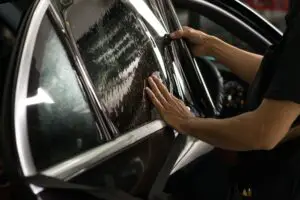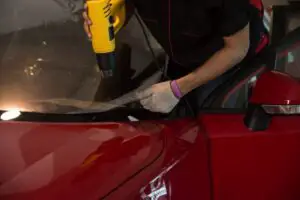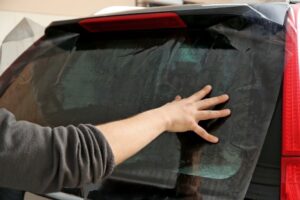From aesthetics to medical requirements, there can be numerous reasons why you would want to apply a window tint to your car.
While you can go about tinting your car windows in any way, you should ensure that they adhere to laws set by the state you are currently in.
Since the rules of each state may overlap, still there is often some sort of obscure rule or exception which may not apply to another state.
That said, you will have to follow that rule in that state.
Throughout my many articles, I have done my best to elaborate on car window tint laws by state, talking about each state individually.
If you want to learn about a particular state, check those out!
In this article, I will talk about the tint laws in general and elaborate on what are the main things you should be on the look for.
Table of Contents
Is Window Tinting Illegal?

The first question that may pop up in your mind when talking about car window tints is whether they are even legal.
The answer to this question will easily depend on the state you are living in. Most states do allow window tints to some degree.
All you have to do is ensure they are within that state’s VLT levels. These VLT levels may vary per window. Some states also do not allow reflective or metallic tints.
Others have banned certain colors on their windows. You must manage this if you want to legally tint your car windows.
You should keep reading this article as I will do a breakdown of which states allow which type of tints on a particular window.
This is integral information as states like Alabama allow 32% tints on the front windshield, but states like New Jersey will not allow any tints on the front windshield.
Discrepancies like this and shifts in values make it extremely hard for people to keep track of what VLT level is allowed in a state.
This is why many people just choose not to tint their car windows.
Legal Window Tint Percentage And Why Should You Care?
Now that I have explained that each state has its own VLT percentage, you might be curious to see which percentage is allowed in your state.
Do not worry, as I will be covering all of that soon. For now, I feel as if I should explain this more in-depth.
Tint percentage or VLT levels correlate to how much light they allow to enter the car. Each state has set its VLT requirements per window.
This means that the VLT limit for the front windshield doesn’t need to be the same for the rear and side windows.
Case in point; the state of Virginia allows 50% tints on the front side windows but only 35% on the rest.
If you have not understood yet, I will say again that these are laws you must follow. You must learn and care about these values, as failure to do so can easily cause you to get pulled over.
The officer will then carry out a test on your windows. Depending on how far your VLT percentage is, you may get fined.
The best way to avoid this is to simply go for higher VLT values as they allow more light to pass through, less in color.
Window Tinting Percentages & Rules Chart In The United States
Getting into the meat of the article, here are all the necessary rules and requirements you need to know about all the states regarding car window tint laws.
| State: | Windshield: | Front Side Windows: | Back Side Windows: | Rear Window: | Reflectivity: | Restrictions: |
| Alabama | Top 6 inches | 32% | 32% (except for Vans & SUVs) | 32% (except for Vans & SUVs) | 20% | N/A |
| Alaska | Top 5 inches | 70% | 40% (except for Vans & SUVs) | 40% (except for Vans & SUVs) | N/A | Green, Gray, Bronze, Neutral, & Smoke Colors are not allowed |
| Arizona | Above AS 1 Line | 33% | Any (except for Vans & SUVs) | Any(except for Vans & SUVs) | 35% | Red & Amber Colors are not allowed |
| Arkansas | Top 5 inches Above AS 1 Line | 25% | 25% | 10% | No metallic or mirrored appearance | N/A |
| California | Top 4 inches | 70% | Any | Any | Not more than the average window No metallic or mirrored appearance | Red, Amber & Blue colors not allowed |
| Colorado | Top 4 inches | 27% | 27% | 27% | No metallic or mirrored appearance | Red & Amber colors are not allowed |
| Connecticut | Top 4 inches | 27% | 27% | 21% | 21% | N/A |
| Delaware | Top 5 inches | 70% | Any | Any | No metallic or mirrored appearance | N/A |
| Florida | Above AS 1 Line | 28% | 15% | 15% | 35% | Not color allowed |
| Georgia | Top 6 inches | 32% | 32% | 32% | 20% | Red & Amber colors are not allowed |
| Hawaii | N/A on size (35%) | 35% | 35% | 35% | No metallic or mirrored appearance | N/A |
| Idaho | Top 6 inches | 35% | 35% | 20% | 35% | N/A |
| Illinois | Top 6 inches | 35% | 35% | 35% | No metallic or mirrored appearance | N/A |
| Indiana | Above AS 1 Line | 30% | 30% | 30% | 25% | N/A |
| Iowa | N/A | 50% | Any | Any | 30% | N/A |
| Kansas | Above AS 1 Line | 35% | 35% | 35% | No metallic or mirrored appearance | Red, Amber & Yellow colors are not allowed |
| Kentucky | Above AS 1 Line | 35% | 8% | 8% | 25% | N/A |
| Louisiana | Above AS 1 Line | 40% | 25% | 12% | N/A | N/A |
| Maine | Above AS 1 Line | 35% | 35% | 35% | No metallic or mirrored appearance | N/A |
| Maryland | Above AS 1 Line | 35% | 35% | 35% | N/A | Red, Amber & Yellow colors are not allowed |
| Massachusetts | Above AS 1 Line | 35% | 35% | 35% | 35% | N/A |
| Michigan | Top 4 Inches | Any (4 inches) | Any | Any | 35% | Silver & Gold colors are not allowed |
| Minnesota | Not allowed | 50% | 50% | 50% | 20% | N/A |
| Mississippi | Above AS 1 Line | 28% | 28% | 28% | 20% | N/A |
| Missouri | Above AS 1 Line | 35% | Any | Any | 35% | N/A |
| Montana | Above AS 1 Line | 24% | 14% | 14% | 35% | Red, Amber & Yellow colors are not allowed |
| Nebraska | Above AS 1 Line | 35% | 20% | 20% | 35% | Red, Amber & Yellow colors are not allowed |
| Nevada | Above AS 1 Line | 35% | Any | Any | N/A | Red & Amber colors are not allowed |
| New Hampshire | Top 6 Inches | 70% | 35% | 35% | No metallic or mirrored appearance | N/A |
| New Jersey | Now allowed | Now allowed | Any | Any | 35% | N/A |
| New Mexico | Above AS 1 Line | 20% | 20% | 20% | No reflectiveness for the windshield. 20% for the rest. | N/A |
| New York | Top 6 inches | 70% | Any | 70% | No metallic or mirrored appearance | N/A |
| North Carolina | Top 5 inches | 35% | 35% | 35% | 20% | Red, Amber & Yellow colors are not allowed |
| North Dakota | N/A on size (70%) | 50% | Any | Any | No metallic or mirrored appearance | N/A |
| Ohio | Top 5 inches | 50% | Any | Any | No reflective tints allowed | N/A |
| Oklahoma | Above AS 1 Line | 25% | 25% | 25% | No reflective tints allowed | No colored tints are allowed |
| Oregon | Top 6 inches | 35% | 35% | 35% | No metallic, reflective, or mirrored appearance | Red, Amber, Black, Gold & Yellow colors are not allowed |
| Pennsylvania | Top 3 inches | 70% | 70% | 70% | Must be non-reflective but mirrored | N/A |
| Rhode Island | Above AS 1 Line | 70% | 70% | 70% | N/A | N/A |
| South Carolina | Above AS 1 Line | 27% | 27% | 27% | No Reflective tints allowed | No colors |
| South Dakota | Above AS 1 Line | 35% | 20% | 20% | No metallic or mirrored appearance | N/A |
| Tennessee | Above AS 1 Line | 35% | 35% | 35% | No metallic or mirrored appearance | N/A |
| Texas | Above AS 1 Line | 50% | 35% | 35% | 20% | Red, Amber & Yellow colors are not allowed |
| Utah | Top 4 inches | 35% (+ 5% buffer) | Any | Any | 43% | N/A |
| Vermont | Above AS 1 Line | Not allowed | Any | Any | N/A | N/A |
| Virginia | Above AS 1 Line | Not allowed | Any | Any | No metallic, reflective, or mirrored appearance | N/A |
| Washington | Top 6 inches | 24% | 24% | 24% | 35% | Red, Amber & Yellow colors are not allowed |
| West Virginia | Top 5 inches | 35% | 35% | 35% | 20% | Red, Amber & Yellow colors are not allowed |
| Wisconsin | No exact rules. No reflective tints | 50% | 35% | 35% | No Reflective tints allowed | N/A |
| Wyoming | Above AS 1 Line | 28% | 28% | 28% | 20% | Red, Amber & Yellow colors are not allowed |
Frequently Asked Questions
Q1. Which State Has The Strictest Window Tint Laws?
It is easy to say that New Jersey has one of the most strict tint laws in the United States. It does not allow tints on the front side windows and the windshield as opposed to other states.
Q2. What Is The Darkest Legal Tint You Can Have?
Limo tints and even darker tints are allowed by certain states. If you want to, you can have completely dark tints which block 100% of VLT. Just make sure your state allows it.
Q3. What States Allow You To Have A Windshield Tint?
According to my research, you can have a windshield tint in most states. The only exceptions are the state of New Jersey and the state of Minnesota.
Q4. Do Window Tint Laws Apply To Out Of State Drivers?
If you travel to another state, you will have to abide by the window tint laws of that particular state.
Because of this, you should ensure that your car’s window tints follow the laws of both states.
Q5. Do I Have To Declare Window Tints To Insurance?
Window tints count as a form of modification to the car. Informing the company is generally a good idea. This will make your insurance claim go more smoothly.
Conclusion
Window tint laws exist to protect police officers. By allowing police officers to see beyond the windows, they can assess potential dangers and identify suspects and criminals.
Window tints make this much more difficult. Understandably, many people have certain conditions that make it necessary to have window tint laws.
The laws are built to cater to these people and make sure that police officers do not put their lives needlessly on the line.
Now that I have gone over all car window tint laws by state, it should be easy for you to follow the rules and avoid any trouble.

I am Tahir Azam, and I have been writing amazing articles for TaxiHack for as long as I can remember. I know everything that is to know when it comes to automobiles and is always on top of industry news and developments. While I am not an expert by any means, I pride myself on knowing the ins and outs of many different problems and, of course, their solutions. The articles on our website are some of the best and well-researched content that you will find, and I spend countless hours making sure this remains to be true. This is why I ask you to take your time out and read some of my articles, especially if you find a topic that resonates with you or is something you are looking into. This way, you will find the perfect mix of information and tips on your desired topic. Learn more about Tahir.



